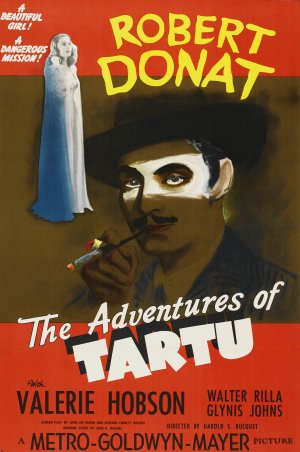The 15th film in Mill Creek’s Fabulous Forties box set was The Adventures of Tartu, a British film from 1943.
The Adventures of Tartu opens during the Blitz and follows Captain Terrence Stevenson (Robert Donat), a British explosives expert, as he defuses an unexploded German bomb in the ruins of London. He does it without breaking a sweat or showing the least bit of hesitation. With his clipped accent and his perfectly trimmed mustache, he’s a British hero through and through. He’s so perfectly British that you expect him to start singing the entire score of H.M.S. Pinafore. He’s the epitome of unflappable resilience.
And he’ll need all of that resilience to survive his next mission! It turns out that, as British as he may seem, Captain Stevenson was originally born in Romania and is still fluent in both his native language and German. Because of this, MI6 recruits him to parachute back into Romania, which is now under the control of the Nazis. Stevenson will assume the identity of a recently assassinated Nazi chemist, Jan Tartu. As Tartu, he will then make his way to Czechoslovakia where a member of the resistance will arrange for Stevenson to get a job at a secret Nazi chemical factory. Stevenson will destroy the factory from within.
Unfortunately, Stevenson’s contact is arrested before he can arrange for job to be assigned to Stevenson. When Stevenson (now pretending to be Tartu) arrives in Czechoslovakia, he is instead assigned to work in a munitions factory. In order to eventually win assignment to the chemical factory, Stevenson now has to win the trust of the Nazis without losing the trust of the resistance. That turns out to be more than a little difficult because, as Stevenson quickly discovers, he is now living in a world where no one can be trusted and everyone is paranoid.
(In one of the film’s best sequences, Stevenson is captured by a group of men and struggles to figure out whether he is now a prisoner of the resistance or a prisoner of the Gestapo.)
I’m not going to go into too many other details, beyond saying that The Adventures of Tartu is an effective and twist-filled work of wartime propaganda. What’s interesting is that when the film starts, it almost feels a bit comedic. Stevenson is so extremely British and the initial Nazis that he meets are so extremely buffoonish that it’s hard to take them seriously. But, as the film progresses, it gets more and more serious. In order to accomplish his mission, Stevenson is forced to make some difficult decisions and likable characters suffer as a result. As Stevenson himself spends more time with the Nazis, both he and the viewer discover just how evil they truly are. (Technically, the viewer should already know that the Nazis were evil but it must be remembered that The Adventures of Tartu was made during World War II, at a time when it was still difficult to get accurate information about what was happening in Nazi-occupied Europe.) By the end of the movie, the Nazis are still buffoons but it’s impossible to laugh at them.
I imagine that wartime audiences left The Adventures of Tartu feeling even more committed to destroying the Nazi regime. Meanwhile, modern audiences will watch The Adventures of Tartu and, once again, be reminded of how fortunate we are that the Allies won the war.
You can watch The Adventures of Tartu below!
